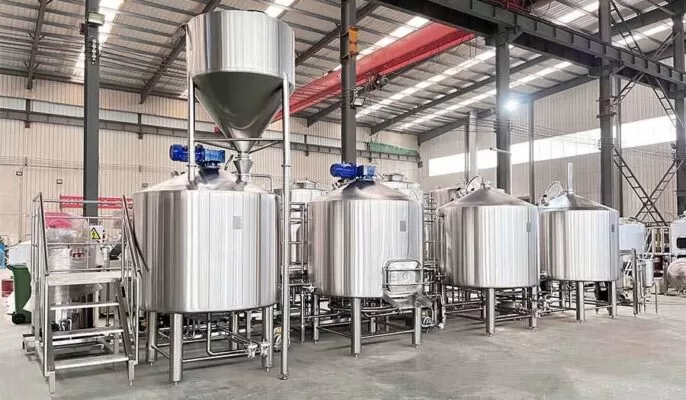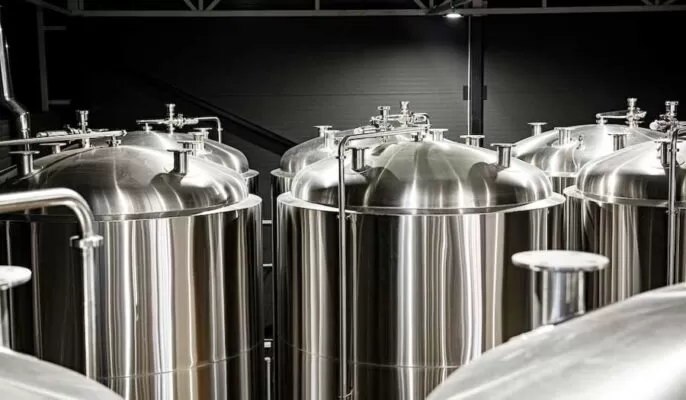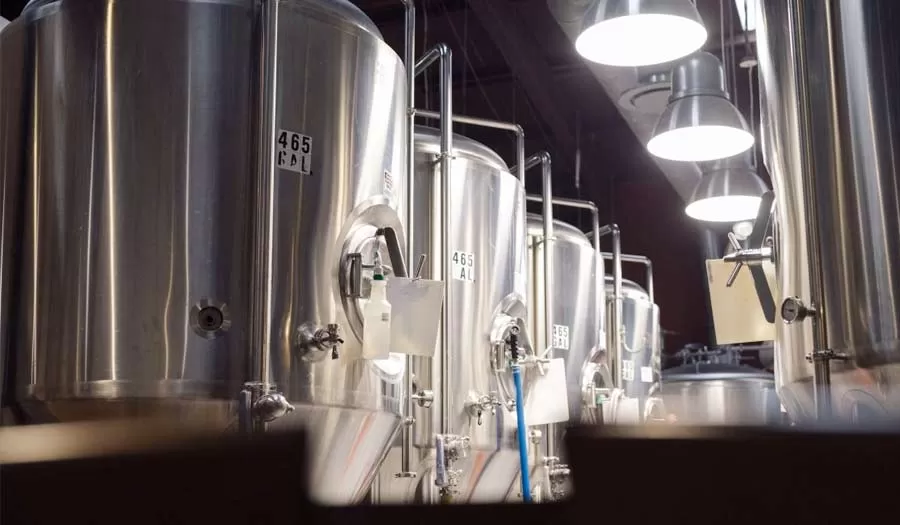Quality brewing equipment is essential for profitable beer production. This guide examines major brewery equipment manufacturers, types of systems, specifications, installation, operation and maintenance tips, and key considerations for selecting suppliers.
Overview of Brewing Equipment
Brewing equipment encompasses the machinery needed to produce beer. The main process steps include:
- Milling – Crushing malt grains
- Mashing – Mixing crushed malt with hot water
- Lautering – Separating liquid wort from grain solids
- Boiling – Cooking wort with hops
- Fermentation – Converting sugars to alcohol
- Filtration – Removing particles and clarifying
- Packaging – Kegging, bottling, canning
Industrial brewing equipment automates this process for large-scale production. Complete systems are engineered to optimize efficiency, quality, sanitation, and output.
Choosing reputable brewing equipment manufacturers ensures reliable equipment that meets target production goals.
Main Types of Brewing Equipment
| Process Stage | Equipment Types |
|---|---|
| Milling | Roller mill, hammer mill, wet mill |
| Mashing | Mash tun, mash filter, mixer, kettle |
| Lautering | Lauter tun, mash filter, grant |
| Boiling | Brew kettle, whirlpool |
| Fermentation | Conical fermenter, CCT, brite tank |
| Filtration | Centrifuge, filter, stabilizer |
| Packaging | Bottler, canner, kegger, depalletizer |
Ancillary equipment like heat exchangers, pumps, piping, chillers, CIP systems, and automation platforms complete the brewhouse.
Configurations include:
- Traditional brew houses with separate vessels
- Integrated brewhouse systems sharing vessels
- Turnkey skid-mounted compact brewhouses
- Nano and microbrewery systems
- Large production industrial breweries
Proper equipment selection and sizing optimizes workflow, floorspace, production goals, and budgets.

Applications of Brewing Equipment
Brewing equipment enables commercial beer production ranging from craft breweries to massive industrial facilities:
| Facility Type | Typical System Size | Production Volume |
|---|---|---|
| Nano brewery | 1-2 BBL system | Under 500 BBL/year |
| Microbrewery | 3-15 BBL | 500 – 15,000 BBL/year |
| Pub brewery | 5-30 BBL | 1,000 – 60,000 BBL/year |
| Regional brewery | 30-75 BBL | 10,000 – 250,000 BBL/year |
| National craft brewery | 50-500 BBL | 50,000 – 1M BBL/year |
| Macro brewery | 500+ BBL | Over 1M BBL/year |
Equipment must align with business model, distribution reach, portfolio, and growth plans. Expanding brewhouses allows incremental increase in capacity.
In addition to commercial beer production, brewing equipment enables:
- Pilot brewing for R&D and testing
- Brewpub onsite craft beer
- Brew-on-premises establishments
- Craft distilling and fermented beverages
- Beverage R&D and pilot facilities
- Brewing education and training centers
Matching equipment capabilities to production goals and budgets ensures smart investments in growth.
Specifications of Brewing Equipment
Technical specifications vary across brewhouse systems and modules. Here are typical ranges:
| Equipment | Key Specifications |
|---|---|
| Brewhouse | Batch size, max ABV, vessel material |
| Mash Tun | Capacity, vessel material, false bottom |
| Lauter Tun | Size, rake design, sparge arms |
| Brew Kettle | Volume, material, heating system |
| Whirlpool | Diameter, tank material, pitch |
| Fermenters | Volume, material, cooling, pressure |
| Brite Tanks | Capacity, jacking, CIP, controls |
| Filler | Speed, can/bottle size, labeling |
Design Factors:
- Cleanability and sanitation
- Process control integration
- Floorspace and ergonomics
- Expandability and flexibility
- Production efficiency
Sourcing brewhouse equipment tailored to your brewing goals optimizes capital investment.
Design Tips for Brewing Facilities
Proper brewhouse design requires strategic planning for:
- Floorplan – Optimize layout and material flow
- Capacity – Match equipment sizes to production goals
- Efficiency – Streamline processes and minimize losses
- Flexibility – Allow for new products and packaging
- Quality – Meet flavor, stability, and consistency targets
- Maintenance – Accessible, cleanable, maintainable
- Expandability – Floorspace and infrastructure for growth
- Budget – Balance performance with capital costs
- Sustainability – Reduce water, energy, and waste
An experienced brewhouse engineering firm is invaluable for cost-effective design. 3D simulation validates the process flow before equipment purchase.
Thorough planning upfront avoids costly changes later on. Investing in the right brewhouse maximizes return on investment.
Selecting Brewery Equipment Manufacturers
Here are key factors in choosing reputable brewing equipment OEMs:
- Expertise – Specialized experience in brewhouses
- Portfolio – Diverse equipment range and sizes
- Quality – Stringent manufacturing standards
- Customization – Flexible integrated solutions
- Service – Installation, operator training, support
- Standards – Certifications for sanitary process
- Testing – Simulations and factory acceptance
- Global network – Sales and service worldwide
- References – Proven track record with customers
- Financials – Financially stable vendor
- Pricing – Competitive costs for value
- Lead time – Swift fulfillment and delivery
Partnering with high-caliber suppliers like JVNW reduces project risks and provides a trusted brewhouse advisor.
Comparing Brewing Equipment OEMs
Major brewhouse and fermentation OEMs include:
| Company | Location | Specialties | Cost Range |
|---|---|---|---|
| JVNW | USA | Integrated brewhouses, custom | $100k – $20M+ |
| Rolec Prozesstechnik | Germany | Brew house systems | $150k – $5M |
| Mainland | Canada | Kettles, tanks, modular | $50k – $2M |
| Spent Just Brew It | Italy | Microbrewery systems | $30k – $500k |
Key Differentiators:
- JVNW offers fully automated USA-made systems with comprehensive services
- Rolec focuses on high-end German engineered brewhouses
- Mainland provides value equipment packages for small brewers
- SJBI supplies simple affordable systems ideal for nanobreweries
Selection Criteria:
- Production quality, consistency, efficiency
- Expandability for future growth
- Customization flexibility
- Responsive service and support
- Total cost of ownership value
- Company stability and longevity
While upfront capital outlay is a factor, the long-term value over the full equipment lifetime is equally important for profitability.
Purchasing Tips for Brewing Equipment
Follow these tips when investing in brewhouse equipment:
- Determine production goals, batch sizes, portfolio
- Research equipment options and top suppliers
- Request quotes outlining entire system
- Compare on quality, production, efficiency
- Validate certifications and compliance
- Require factory acceptance testing (FAT)
- Review simulation data on performance
- Include installation and operator training
- Confirm service response time and parts access
- Negotiate payment terms favorable to cash flow
- Get references to confirm vendor reputation
- Start small and expand systems over time
- Seek financing assistance if needed
Thorough due diligence reduces unexpected problems and costly downtime once production begins.
Operating and Maintaining Brewing Equipment
To sustain optimal performance:
- Follow manufacturer instructions for operation
- Perform preventive maintenance on schedule
- Inspect equipment routinely for issues
- Clean and sanitize vessels and piping thoroughly
- Lubricate and replace wear parts as needed
- Monitor process variables and control points
- Validate instrument calibration routinely
- Document procedures and record data trends
- Involve OEMs for periodic major maintenance
- Address problems quickly to prevent bigger issues
- Improve maintenance practices continually
Good manufacturing practices and HVAC systems also contribute to consistent quality and production.
How to Choose the Right Brewing Equipment Supplier
Selecting the best brewing equipment partner involves:
- Identifying reputable equipment manufacturers with brewing expertise
- Researching their project experience and engineering qualifications
- Validating production quality and customer results firsthand
- Requesting references from clients of similar size
- Comparing product offerings and business models
- Examining equipment construction and capabilities
- Reviewing proposals and process simulations in detail
- Inspecting factory testing prior to shipment
- Evaluating aftersales support infrastructure
- Negotiating pricing, delivery, and payment terms
- Choosing a strategic advisor willing to learn your business
Taking time to confirm suppliers’ expertise upfront avoids costly mistakes later on. The ideal partner contributes to the success of the entire brewing venture.

Pros and Cons of Brewing Equipment
Advantages
- Automates brewing for efficiency and consistency
- Allows scaling up production in stages
- Reduces labor, water, energy compared to manual processes
- Enables craft recipes and production innovations
- Provides flexibility for different beer styles and packagings
- Improves quality control and food safety
- Streamlines material flows in facility layout
- Engineered for rapid cleaning and sanitation
- Customizable to specific brewing requirements
Disadvantages
- Substantial capital investment required
- Technical skill needed for programming and maintenance
- Large footprint for equipment and operations
- Inflexible for major production process changes
- Upgrades needed over time as demands evolve
- Significant maintenance and parts replacement
- Potential for downtime and lost production
- Used equipment has big risk of hidden problems
- Long equipment lead times for delivery and install
When appropriately designed and maintained, automated brewing systems provide vastly higher productivity and beer consistency than manual methods.
FAQs
What types of metals are brewing vessels made from?
Stainless steel is predominantly used for food contact surfaces. Aluminum, mild steel, and copper may also be used in kettles.
What determines the size of brewhouse equipment?
Batch volume, annual production goals, beer types, and packaging methods dictate equipment sizing.
How long does brewery equipment last?
With proper maintenance, major systems have a working lifespan around 20-30 years.
How much does a 10 barrel brewhouse cost?
Around $250,000 to $750,000 depending on degree of automation and peripherals.
What standards apply to brewing equipment?
ASME pressure vessel codes, 3A sanitary standards, UL electrical safety, and others.
Can I expand a brewhouse over time?
Yes, with proper planning, brewhouses are modular to incrementally add capacities.
Are there mobile or containerized brewhouses?
Yes, compact turnkey container brewhouses are available for small batches.
What are the power requirements?
Three phase 480V electrical supplies are typical, with power depending on equipment size.
Is used brewing equipment a good value?
Used equipment carries major risk of problems. Leasing returns may provide better value.
Should I work with a brewhouse engineering firm?
Yes, experts manage equipment scoping, design, procurement for best results.
What are typical brewhouse warranty terms?
12 months is common. Extensions up to 24 months may be negotiated.




